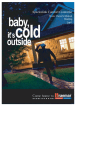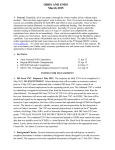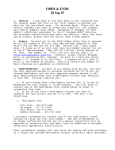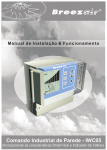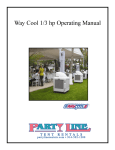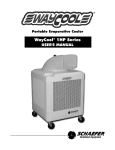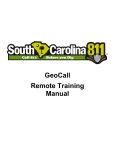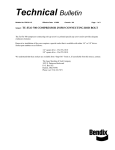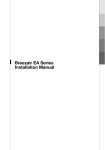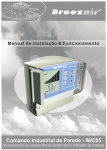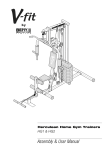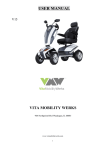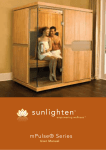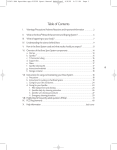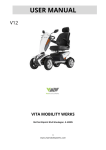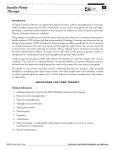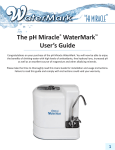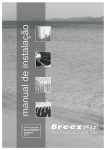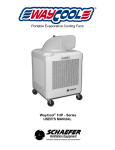Download BREEZAIR USER`S MANUAL
Transcript
BREEZAIR USER’S MANUAL April, 2001 TABLE OF CONTENTS WARRANTY ..................................................................................................1 INTRODUCTION .............................................................................................2 Why use evaporative coolers in your work place?.............................................. 2 How evaporative cooling works ........................................................................... 3 SAFETY ........................................................................................................4 SPECIFICATIONS ...........................................................................................5 ICE3 UNIT DESCRIPTION................................................................................6 WATER SUPPLY SYSTEM ...............................................................................8 COOLING PAD ASSEMBLY ...........................................................................12 BLOWER AND DUCTWORK ...........................................................................13 CONTROL ...................................................................................................15 OPERATION AND MAINTENANCE ...................................................................16 Unit placement and other considerations................................................................ 16 Unpacking and Initial Setup .................................................................................... 17 Regular Cleaning..................................................................................................... 18 Normal Startup ........................................................................................................ 19 Normal Shutdown.................................................................................................... 20 TROUBLESHOOTING .....................................................................................21 Cooling Pads not Wetting........................................................................................ 21 Foaming................................................................................................................... 21 Line Clogs or Obstructions ...................................................................................... 22 Leaking out Front .................................................................................................... 22 Leaking out Bottom ................................................................................................. 22 Ordering Replacement Parts .................................................................................. 23 Since 1989, Patterson Fan has built a tradition which is centered around our commitment to giving each customer more than just "Off The Shelf" equipment. While most fan manufacturers rely on catalog houses and independent distributors to market their products, Patterson Fan continues a tradition of direct customer involvement. We will work directly with you in developing an analysis of your facility's environment and air movement needs before making any product recommendations. Our business is to provide innovative, cost-effective air movement solutions that achieve your needs and exceed your expectations. Our manufacturing capabilities allow us to be flexible and swift in providing an air movement system that meets your specific requirements. Patterson Fan is dedicated to constant improvement, innovation and invention. WARRANTY Patterson Fan warrants this equipment to be free from defects in materials and workmanship for one year from shipment date. Any units or parts which prove to be defective and are reported during the warranty period will be repaired or replaced, at our option when returned to our factory transportation prepaid. Deterioration or wear caused by abrasive action, chemicals, improper installation, operation or lack of normal maintenance is not considered defective, and is not covered by warranty. The motor is warranted by the motor manufacturer for one year. If the motor becomes defective in the warranty period, it should be taken to the nearest authorized motor service station. If this action is not taken, the motor manufacturer will not warrant the motor. The warranty stated herein is in lieu of all other warranties, expressed or implied. Patterson Fan Company 1120 Northpoint Blvd. Blythewood, SC 29016 tel: 800.768.3985 fax: 803.691.4751 Patterson Fan West 9668 Heinrich Hertz Dr., Suite D San Diego, CA 92154 tel: 877.847.1951 fax: 877.844.3805 INTRODUCTION WHY USE EVAPORATIVE COOLERS IN YOUR WORKPLACE? · The Patterson Fan ICE 3 evaporative cooler requires little space, has a low initial cost, is inexpensive and simple to operate and requires minimal scheduled maintenance. · Due to the design and construction of the cooling pads, cooling efficiency is normally maintained near optimum throughout the life of the pads, which can easily last for two or more seasons with proper care. · In many cases, evaporative coolers are a better solution than mechanical refrigeration systems because they are more economical to operate and maintain and do not use environmentally-sensitive refrigerants. 2 3 Model ICE Patterson Fan Company, Inc. INTRODUCTION WHAT IS EVAPORATIVE COOLING? Figure PF-02 – Evaporative Cooling Principle Evaporative cooling is the same process your body uses to cool itself. When you perspire, and air moves across your skin, a portion of the perspiration (water) evaporates. Evaporation requires heat to change liquid water to water vapor. This heat is taken from your skin and produces the cooling effect. In an evaporative cooler, the fiber cooling pads take the place of your skin, water instead of perspiration wets them and a fan moves the air. As the air blows across the cooling pads and evaporates moisture, heat is drawn from the pads and the air, dropping the air temperature and producing the cooling effect. The cooled air is then forced through a building or space and displaces the warm air out building openings and cooling the surroundings. In addition, the high air velocity increases the cooling effect as it moves over the skin of people in the air flow path. Patterson Fan evaporative coolers are portable and use the latest technology to provide large volumes of cool air, efficiently and inexpensively for cooling small to medium size areas. Adding more units accommodates larger areas. With proper sizing and application, a Patterson Fan evaporative cooler can lower the effective air temperature by fifteen degrees or more. Even in high humidity, the efficiency of the Patterson Fan evaporative cooler provides effective cooling. 3 3 Model ICE Patterson Fan Company, Inc. INTRODUCTION For over thirty years, scientists and engineers have studied the interaction between air and water and its ability to produce a cooling effect. By developing the technology, they have optimized the most effective ways to achieve indoor climate control. The corrugated cooling pads used in the Patterson Fan evaporative coolers represents the most energyefficient means of cooling and humidifying air currently available. This means that it is now economical and practical to provide cooling to spaces previously considered too costly to cool. In many cases, evaporative coolers are a better solution than mechanical refrigeration systems because they are more economical to operate and maintain and do not use environmentally-sensitive and costly refrigerants. The energy efficiency of a Patterson Fan evaporative cooler is self-evident when you examine the facts: Operating costs are about one-tenth that of compressor refrigeration systems. Evaporating one quart of water produces the same cooling effect as melting fifteen pounds of ice. 4 3 Model ICE Patterson Fan Company, Inc. SAFETY · Shut off and unplug the unit before you inspect or clean the internal components. · Never reach into the unit when it is running; you could become entrapped by the v-belt or injured by the rotating fan blades. · Do not service the electrical components unless you are certified to do so. · The metal frame edges are sharp, don’t run your hand along them. Be careful and wear gloves when you reach under the frame to inspect the distribution pipe sleeves. · A GFCI (Ground Fault Circuit Interrupter) is recommended for use near water. 5 3 Model ICE Patterson Fan Company, Inc. SPECIFICATIONS · Height and Width – 34" X 33" Wide X 54" High (with casters and blower duct) · Shipping Weight – 225 Pounds · Operating Weight – 350 Pounds · Blower – Double-Inlet Centrifugal · Motor – 1 HP, 115 V, 60 Hz, 2-Speed (also available in 230V/50Hz) · Pump – Submersible, Vane Type, 280 GPH (Gallons Per Hour) · Pump Inlet Filter – Washable Porous Polyethylene · Pump Discharge Filter – Removable 480 Micron Stainless Steel · Reservoir Capacity - 24 Gallons · Optional Water Supply – Standard ¾" Hose Connection (garden hose size) · Housing – High Impact ABS Plastic with UV Protection · Evaporation Media – Chemically Treated Cellulose Paper 6 3 Model ICE Patterson Fan Company, Inc. PF UNIT DESCRIPTION Figure PF-03 Evaporative Cooler Overview The Patterson Fan evaporative cooler is a completely self-contained, portable unit capable of delivering a large volume of high-velocity air which is up to 20 degrees cooler than the surrounding air. The unit is composed of: · · · · · level-controlled water supply system cellulose cooling pad assembly motor-driven fan and ductwork controls frame and housing The bottom is made of molded plastic and holds approximately 24 gallons at normal operating level (about 5" deep). A float-operated valve automatically maintains proper water level when the unit is connected to a water supply. The bottom water basin rests on and is fixed to an aluminum cradle which supports the water basin. The cradle in turn is secured to the aluminum frame. Four casters (2 locking, 2 regular) attach to the underside of the aluminum cradle. 7 3 Model ICE Patterson Fan Company, Inc. PF UNIT DESCRIPTION A pump draws water from the basin and discharges it through a vinyl hose to the PVC pipes located above the cooling pads. The PVC pipes spray water onto the top of the cooling pads and saturates them. Excess water drips back into the water basin through holes in the support channels. The cellulose cooling pads sit in channels and are held in place by plastic retaining screens. The screens also help prevent crush damage to the cooling pads. Two pad sections fit in each side of the unit (total eight sections) to totally enclose the blower and water basin space. Optional prefilters are available for very dirty air to extend the normal cleaning cycle. The blower is hung from the top of the frame and driven by a belt-driven 1 HP electric motor. The blower draws room air through the cooling pads where it picks up moisture and cools by evaporation. The blower then discharges the cooled air out the duct and the directional hood to the cooled space. The cooled air displaces the warmer air out open windows and spaces in the building. Note: It is important the cooled space has sufficient air openings so the warmer air can flow out and be replaced by the cooled air. A closed-in space or high humidity will reduce the cooling effect. See Unit Placement and Other Considerations in the “Operation and Maintenance” section of this manual. A screen covers the discharge duct to prevent foreign objects from entering the blower. A threaded rod screws through a threaded brace above the screen to hold the blower hood in position. A plastic nut secures the blower duct to the rod. The blower duct is made of a tough, durable plastic and can be manually rotated 360 degrees to provide cool air in any direction without moving the unit. Note: Water weighs about eight pounds per gallon, so when the unit is full, it weighs over 375 pounds. During setup and before startup, place the unit in the desired location, then fill the basin. Do not attempt to lift the unit once it is filled and be careful to avoid spills when moving it; even over smooth ground. Do not try to push it over rough or soft ground as you can overstress the wheels and frame and cause structural and component damage which is not covered by warranty. 8 3 Model ICE Patterson Fan Company, Inc. WATER SUPPLY SYSTEM Figure PF-04 - Water Supply System The bottom can be supplied continuously with an ordinary garden hose by attaching the supplied adapter hose (see Figure PF-07) to the fill connection, or it can be filled manually. With a continuous water supply connected, the float valve in the basin (like the one in your toilet tank) rises and falls with the water level. A linkage attaches the float to the shutoff valve in the fill connection. As the water level rises to normal operating level (about 5" deep), the float valve shuts off the water supply. When the water level drops, the float valve reopens to maintain normal operating level. Note: When you use the adapter hose, first wrap the fill connection pipe threads with teflon tape and tighten slightly with a wrench to ensure a leak-proof seal. Also check that the washer is in place in the female end. The water basin can also be manually filled with a hose or bucket if a hose connection is impractical. Unplug the unit and remove any of the side panels and one of the cooling pad sections and place the hose or pour the water directly into the basin. When you fill the basin manually, it can be filled to a higher level, but make sure someone monitors the filling operation to avoid overfilling and flooding. 9 3 Model ICE Patterson Fan Company, Inc. WATER SUPPLY SYSTEM Note: We have intentionally left out a manual fill connection due to the likelihood of overfilling and consequent flooding if the basin water level is not visually monitored during manual filling. Water damage due to overfilling is not covered by the warranty. Note: When you run the unit and manually fill it, check the water level frequently so it does not run dry. Operating the pump without water will damage it or reduce its service life. This is not covered by the warranty. The cooling effect also stops if the pads dry. A drain at one corner of the water basin allows you to drain it for cleaning and maintenance. A drain cap on the underside of the aluminum tray covers the drain during operation. Make sure the cap is in place before you fill the basin. The drain cap should only be finger-tight. The water basin provides suction to the pump which supplies water to the cooling pads. The pump is attached to a bracket which in turn is fixed to the blower housing. The bracket holds the pump in its proper position, on top of the foam filter, just above the basin bottom, allowing sufficient space for water to enter the pump suction. The pump power cord runs along the basin bottom and runs up the frame leg that has the control switch (see cover fig). The three-pronged end of the pump cord plugs into a female plug on the inside of the frame leg. This allows the pump to be easily removed and replaced without the services of a qualified electrician. Figure PF-05 - Pump Inlet Screen A small plastic screen covers the pump inlet to prevent foreign matter entering and damaging the pump impeller. The screen snaps in place and can be easily removed for inspection or cleaning. 10 3 Model ICE Patterson Fan Company, Inc. WATER SUPPLY SYSTEM Figure PF-04 - Water Supply System The pump sits on a foam filter, somewhat like a sponge. The filter traps dirt that could enter the water distribution system and build up on the cooling pads and reducing their effectiveness. Dirt can also accumulate in the PVC pipes and plug the spray holes, causing the unit to "spit" water out the sides. See instructions for cleaning the PVC pipes. The pump discharges through a fine, washable screen filter which decreases the contamination of the cooling pads and water system. The discharge filter casing is a clear plastic so dirt buildup on the internal screen is easily visible. As dirt builds up, water flow to the cooling pads is reduced and performance decreases. The clear filter housing is threaded and screws into the filter body for easy removal to access the screen. Note: A dirty water supply will quickly reduce the cooler's performance and the unit will require more frequent cleaning to maintain cooling effectiveness. Always try to use a filtered, treated water supply. A clear vinyl hose connects the pump to the filter. From the filter, a "T" connector supplies two lines that run along the bottom and up opposite frame corners to supply water to the PVC pipe. Each vinyl hose connects to two PVC pipes, which run horizontally along the top of the frame above the cooling pads. 11 3 Model ICE Patterson Fan Company, Inc. WATER SUPPLY SYSTEM Figure PF-06 Water Distribution and Cooling Pads The PVC pipes have a series of holes on the top side and run the full length of the bar. Each PVC pipe is covered with a plastic mesh sock which helps break up the water as it leaves the spray holes. This gives a more even water distribution across the cooling pad and reduces splashing. The holes direct the water upward where it splashes against the channel, then falls back down to continuously saturate the cooling pads from the top down. Excess water drains back to the basin through drainage holes in the bottom metal channels which support the cooling pads. Note: Water cleanliness has a major effect on the cooler's performance. Use a clean water supply, and consider a water softener if your water is hard. Dissolved solids in hard water deposit on the cooling pad surfaces and reduce the air flow through the unit and therefore the amount of evaporation. Note: The cooler also acts as an air filter and removes dust and other particles from the air. This dirt collects on the cooling pads and lowers cooler efficiency. The pads should be cleaned at least weekly and more frequently in dusty conditions. See Regular Cleaning under "Operation and Maintenance". Prefilters are also available. Ask your dealer about this option. 12 3 Model ICE Patterson Fan Company, Inc. COOLING PAD ASSEMBLY The cooling pads are critical to proper, efficient cooler operation. They are made of laminated cellulose (paper) fibers, and arranged to give a large surface area for evaporation and to provide a rigid structure. The shape of the cells allows high velocity air flow through the pad at minimum pressure drop. At the same time, the air passages between the cells force the incoming air to impinge on the wet cell surfaces and maximize evaporation. The pump supplies a continuous flow of water over the pads, causing a "sheet flow" which constantly replaces the water lost to evaporation and keeps the pads saturated. One cubic foot of the cooling pad material holds about a gallon of water during operation. One cubic meter holds about 100 liters of water. Note: The cooling pads are relatively strong but are subject to crushing, especially when wet. Always run the unit with the plastic retaining screens in place and handle them carefully when you clean them. Crushed cells reduce the total air flow through the unit and therefore lowers its cooling capacity. The cooling pad sections, two sections for each side (eight sections total), sit in metal channels at the top and bottom of the unit. The channels hold the cooling pads in position and form four side walls to completely enclose the unit. The top channels house the distribution spray bars which run horizontally along the channel directly above the cooling pads. The bottom channels have a series of holes drilled through them to allow excess water flowing down the cooling pads to return to the basin. The plastic retaining grates fit in front of the cooling pads and sit in the same channels as the pads; holding them in place and protecting them from accidental damage. The plastic grates and cooling pads are easily removed by placing a flat blade under the bottom and lifting upwards, then outwards. Once one pad is removed, the others can be lifted up and out by hand without using a blade. Note: Do not remove or handle the cooling pads when they are wet, as they damage easily. Run the blower without the pump until they are dry. With normal care, the pads should last at least two seasons. Abuse or mishandling will reduce their effectiveness and shorten their life. 13 3 Model ICE Patterson Fan Company, Inc. BLOWER AND DUCTWORK Figure PF-07 – Fan Blower The ICE 3 uses a belt-driven 1 HP electric motor to drive a centrifugal blower. The blower draws room air through the cooling pads and discharges the cooler air through the blower duct, displacing the warmer air with cooler air and lowering the temperature. The blower discharge duct is secured to the top of the frame and hangs upside down to direct the air out the top of the unit. Brackets on each side of the blower casing secure the blower to the frame and hold it in position. The electric motor is bolted to a metal bracket on the blower casing. A V-belt connects the pulley on the motor shaft to the larger pulley on the blower shaft. Both shafts have sealed roller bearings which do not require lubrication. A belt tensioner is connected to a bracket on the motor. A rubber foot at the other end rests against the blower casing. When the locking nut is backed off, the bolt can be turned in to tighten the V-belt or backed out to loosen or remove the V-belt. Note: Do not overtighten the V-belt as you can prematurely wear out the bearings or dent the blower casing where the rubber foot rests against it. 14 3 Model ICE Patterson Fan Company, Inc. BLOWER AND DUCTWORK The power cord runs down the frame leg that has the control switch on the outside. It exits the frame leg at the bottom and has a three-pronged male plug that plugs into a normal 120 volt outlet. The cord is about seven feet long. Note: The ICE 3 unit requires 120 volts and 12 amps of power. This is normally available on most household circuits. However, if you are running a number of other items on the same circuit, you may trip the breaker. If so, plug the cooler into another circuit. If you require and extension cord, make sure it is at least #14 wire and no longer than 50 feet. If you need a longer cord, use one with #12 wire. Using smaller wire or a longer cord will degrade the cooler's performance, shorten the life of the electric motor and could cause a fire. None of this is covered by warranty. A GFCI (Ground Fault Circuit Interrupter) is recommended for use near water. 15 3 Model ICE Patterson Fan Company, Inc. OPERATION AND MAINTENANCE Figure PF-08 – ICE 3 Control Switch The ICE 3 control switch is mounted on the outside of one frame leg (see cover fig). It has the following positions: OFF – Power is off to the blower motor and the pump motor. LOW VENT – The blower runs at low speed and the pump is OFF. HIGH VENT – The blower runs at high speed and the pump is OFF. Use this setting to quickly dry the cooling pads for removal and cleaning. LOW COOL –The blower runs at low speed and the pump is on. Use this setting for low cooling loads. HIGH COOL –The blower runs at high speed and the pump is on. Use this setting for maximum cooling. PUMP ONLY – Pump is on and the blower is OFF. Use this setting during startup to first saturate the cooling pads, then switch to LOW COOL or HIGH COOL to begin cooling. 16 3 Model ICE Patterson Fan Company, Inc. OPERATION AND MAINTENANCE UNIT PLACEMENT AND OTHER CONSIDERATIONS 3 3 ICE ICE Figure PF-09 Typical Unit Arrangement The unit(s) should be placed at one end of the building and some sort of exhaust fan should be at the opposite end to pull the cool air from the unit and discharge the warm air out of the building. Try to get all the air flowing in the same direction. Do not direct other fans against the unit. It will counter the cooler's airflow and stop the cooling effect. Obstructing the airflow from the unit severely reduces the cooling effect. Avoid using ceiling fans as they disrupt the airflow from the unit. Use as many exhaust fans as possible to create a natural draft through the building. This will enhance the cooler's performance. 17 3 Model ICE Patterson Fan Company, Inc. OPERATION AND MAINTENANCE UNPACKING AND INITIAL SETUP The ICE 3 Evaporative Cooler is shipped upright in a corrugated container. The unit is fully assembled and ready for service except for removing the container, the adapter hose and thoroughly cleaning manufacturing dust from the cooling pads before running it for the first time. CAUTION: Be careful when you move the unit while it is in the shipping container and when moving it around with the container removed. Avoid jarring or dropping the unit to prevent damage to the bottom from the frame legs. 1. With the unit in the upright position as marked on the container, use a sharp knife or scissors to cut the straps that wrap the shipping container. Note: Do not discard the container until you have thoroughly inspected the unit. 2. Remove the shipping container. 3. The water supply adapter hose is shipped attached to the threaded rod that secures the directional hood. Remove the hose by cutting the plastic tie wrap with scissors or a knife. 4. Check the switch is OFF and the unit is unplugged. 5. Remove the plastic retaining grates from all four sides of the unit. Use your fingers to lift each upward, then outward from the bottom. Figure PF-10 18 3 Model ICE Patterson Fan Company, Inc. OPERATION AND MAINTENANCE 6. Remove the cooling pads from all four sides of the unit. Place a putty knife or large, flat-bladed screwdriver under the pad to lift it up, then outward. With one pad out, the rest can be easily removed by placing one hand on the pad's inside, your other hand on the outside and lifting the pad up and out from the bottom. (See Figure PF-10). 7. Inspect the entire unit for shipping damage. 8. Ensure the V-belt is attached to the motor and blower pulleys and that the belt tension is correct. To check for proper tension, press your finger on the belt about halfway between each pulley. It should have about a half inch of play. Too loose and the V-belt will slap around while running. Too tight will cause the pulley bearings to wear and fail prematurely. 9. Look for cracks in the bottom near the frame legs. This is also an indication of rough handling. 10. Ensure the frame legs are straight and in alignment and that the blower is sitting level and in proper position. Note: If you notice any damage to your unit, immediately contact the dealer where you purchased it. 11. Clean thoroughly all eight cooling pad sections using a garden hose. Note: Do not use cleaning fluids or other chemicals to clean the pads or it can cause foaming during operation. Use only clean water. 12. Remove the drain cap from the underside of the bottom and rinse with a hose to flush any manufacturing dust, etc. from the unit. Replace the drain cap. 13. Replace the pads and the protective retaining grates. 19 3 Model ICE Patterson Fan Company, Inc. OPERATION AND MAINTENANCE REGULAR CLEANING The cleaning frequency depends on the environment in which it is used. The dirtier the environment the more often it requires cleaning. In most cases, it should be cleaned weekly. Caution: The pads should be dry before you handle them as they are stronger and less susceptible to damage when dry than when they are wet. If they are wet, run the unit in the HIGH VENT position until they are dry. After cleaning, let the pads air dry before you replace them. 1. Turn the switch to OFF and unplug the unit. 2. Remove the plastic retaining grates and check the pads for cleanliness. If they are dirty, remove and clean with a garden hose. If they are not dirty you will still need to remove the pads to clean the inside of the unit. Dirty cooling pads reduce the unit's effectiveness. 3. Use a garden hose to rinse out the basin and the inside of the unit. The dirt that accumulates is removed from the air during operation, as the unit also acts as an air filter. 4. Remove the drain cap from the underside of the unit and let the unit drain completely. Rinse out remaining dirt. 5. Replace the drain cap (finger tighten only). 6. Remove the pump discharge filter by unscrewing the top, removing the screen and rinsing it with the hose or under a tap. Replace the filter screen and screw the top back on. 7. Remove the pump filter from underneath the pump and wash thoroughly with the hose. Compress the filter and place it back under the pump. 8. Replace the cooling pads once they are dry and reinstall the plastic retaining grates. Note: With proper use and regular cleaning, the cooling pads will last about two seasons. If you handle them wet and are abusive, however, they will be easily damaged. 20 3 Model ICE Patterson Fan Company, Inc. OPERATION AND MAINTENANCE NORMAL STARTUP 1. Place the unit in position where it will be run. Do not attempt to lift or move the unit once it is filled or damage to the unit or a large spill may occur. Make sure the unit is level at all times. Note: When you place the unit, keep it at least three feet away from walls and make sure there are no obstructions that will disrupt or block the air flow into the unit. 2. Place a wrap of teflon tape around the male end of the adapter hose to prevent a leak. 3. Connect the adapter hose to the fill connection and tighten it slightly with a wrench. 4. Check the drain cap is in place and secure. 5. Connect the garden hose to the adapter hose. Check that there is a washer in the hose connection's female end. 6. Open the water supply valve and check that water enters the basin through the float valve by removing one cooling pad on the side with the water connection. Allow the unit to fill and check that the float valve completely shuts off the water. 7. If you are manually filling, remove one or more cooling pads and fill the bottom with a bucket or hose. 8. Visually monitor the filling operation to avoid overflowing and causing spill damage. We did not put a manual fill spout on the unit specifically to avoid unattended manual filling. 9. Plug the unit into an ordinary 120 volt home wall outlet. If you need an extension cord, use a #14 and keep it under 50 feet long. If you need to go longer, use a #12 cord. CAUTION: If you use an improper extension cord, you will shorten the life of the motor and degrade the unit's performance. 10. Adjust the blower duct to discharge the cool air in the desired direction and tighten the knob on the end of the threaded rod. 21 3 Model ICE Patterson Fan Company, Inc. OPERATION AND MAINTENANCE 11. Place the control switch in the PUMP ONLY position and let it run for about ten minutes to saturate the cooling pads. Check that the pads are wetting completely and there are no dry spots. CAUTION: Do not run the pump without water in the bottom or you will damage the pump. Running the pump dry voids the pump warranty. 12. Place the control switch in the LOW COOL or HIGH COOL position to begin normal cooling operation. NORMAL SHUTDOWN 22 1. Place the control switch in the HIGH VENT position and let the unit run until the pads are dry. 2. Place the control switch to OFF. Unplug the unit if you are going to clean the pads or inspect the internals. 3. Shut off the water supply. 4. Drain the bottom if you are going to clean it. 5. If the unit will be stored for the season, ensure the cooling pads are completely dry, then remove them. Wrap them in plastic bags or store them in a clean place where they will not be damaged or get dirty. Clean the unit before storing. 3 Model ICE Patterson Fan Company, Inc. TROUBLESHOOTING FOAMING Foaming is generally caused by a dirty water supply or contaminated water in the bottom. 1. If foaming occurs, stop the unit, drain it and flush the basin and insides thoroughly with clean water. 2. Clean the pads and do not use any kind of chemical cleaners. If time and weather permit, let the pads dry in the sun. 3. Reassemble, refill and restart. COOLING PADS NOT WETTING 1. Ensure that the bottom has water. 2. Ensure that the switch is in the proper position HIGH COOL, LOW COOL or PUMP ONLY. These are the positions that run the pump. 3. Ensure that the pump is running. Remove the pads on the control switch side. Check that the hose is connected to the pump. 4. If the hose is connected, remove it and run the pump. If you feel water coming out the pump, it is OK and you probably have a dirty filter or a line clog. See "Obstruction or Line Clog". 5. Inspect and clean the pump discharge filter. 6. If the pump is running and you can't feel water coming out after disconnecting the hose in step 4 above, shut down and unplug the power. 7. Remove the pump bracket retaining screw. 8. Check that nothing is obstructing the pump intake screen or that it is not pressed flat against the bottom. 9. Remove the pump intake screen and check that nothing is plugging the pump impeller. Turn the impeller by hand to see if it turns freely. 10. If there are no obstructions, unplug the pump power cord from the pigtail connection attached to the control switch. 11. Plug the pump power cord directly into a wall receptacle. If it runs, the control switch is bad. If it does not run, the pump is bad and must be replaced. 23 3 Model ICE Patterson Fan Company, Inc. TROUBLESHOOTING LINE CLOGS OR OBSTRUCTIONS (LITTLE OR NO WATER FLOW) Depending on the cleanliness of the water and the amount of dirt, dust, etc. in the supply air, you may have to clean the PVC pipes from time to time. Your own experience will dictate the frequency. 1. Turn off and unplug the unit. 2. Remove the plastic knob from the threaded rod. 3. Remove the blower duct and set it aside. 4. Remove the two screws that hold on the unit's top cover. 5. Remove the top cover and set it aside. 6. Note each PVC pipe is secured to the "Y" connector by a single screw. Remove this screw from all four PVC pipes. 7. Grip with pliers the opposite end of each PVC pipe and gently twist it out of its "Y" connector. 8. Remove the plastic mesh socks from the PVC pipes and clean them in warm, soapy water. 9. Direct a jet of water at the series of outlet holes in the PVC pipes to blow them clear. 10. Direct the water nozzle into the end of each pipe and blow them clear. Inspect them for cleanliness and repeat if necessary. 11. Reinstall the socks over the PVC pipes taking care not to bunch them. 12. Replace the PVC pipes taking care to ensure the water outlet holes are facing upwards. There is a mark on the PVC pipe that indicates the UP position. Note: Ensure you push the PVC pipes fully into the "Y" connectors so the retaining screws go through the connector and the pipe to hold them in. LEAKING Out Front - See "Line Clogs or Obstructions". Out Back - Check for cracks on the bottom. If a crack is found, you need to order a new bottom. See "Ordering Replacement Parts". 24 3 Model ICE Patterson Fan Company, Inc. ORDER REPLACEMENT PARTS ORDERING REPLACEMENT PARTS To order replacement parts contact the dealer from whom you purchased your unit. If you do not have that information, call Patterson Ventilation Industries, Inc. at 1-800-768-3985. Fill in the following information for quick reference: Dealer Name ________________________________ Address ____________________________________ Phone ______________________________________ Serial Number _______________________________ 25 3 Model ICE Patterson Fan Company, Inc.



























